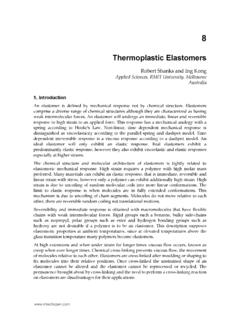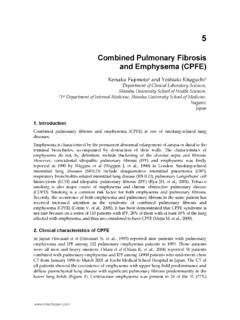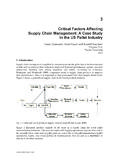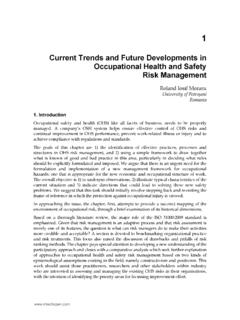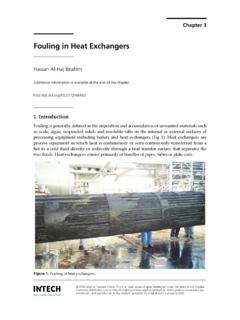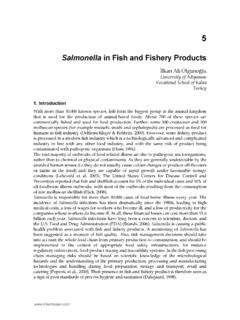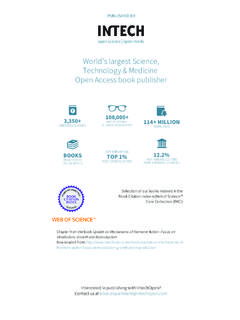Transcription of Chitosan Based Membranes for Separation, Pervaporation …
1 10. Chitosan Based Membranes for separation , Pervaporation and Fuel Cell Applications: Recent Developments Tina Chakrabarty, Mahendra Kumar and Vinod K. Shahi Electro- membrane Processes Division, Central Salt and Marine Chemicals Research Institute, Council of Scientific & Industrial Research (CSIR), G. B. Marg, Bhavnagar-364002 (Gujarat). India 1. Introduction Growing public health and environmental awareness accompanied by increasing number of stricter environmental regulations on wastes discharge. Attention has been focused on the use of biopolymers from renewable resources as alternatives to synthetic polymers [1]. Biopolymers are produced in nature by living organisms and plants, participate in the natural biocycle and are eventually degraded and reabsorbed in nature.
2 The most widespread biopolymers are polysaccharides among them Chitosan (CS) is most valuable, whose swellability in water and viscous solution/gel-forming properties were utilized by manufacture for number of industrial and consumer products. CS (primary derivative of chitin) is commercially available basic polysaccharide [2,3]. The basicity of CS responsible for singular chemical and biological characteristics, biocompatibility, antibacterial properties, heavy metal ion chelation ability, gel-forming properties, hydrophilicity, affinity to proteins and good membrane forming capability. In this chapter we will discuss for modification of CS and its exploitation for advance membrane separation applications. The membrane processes were classified by Howell includes [4]: 1.
3 Cleaner industrial process: adsorption, ultrafiltration and electro-ultrafiltration. 2. Energy: fuel cell applications 3. Pervaporation : separation of organic solvents from their azeotropic mixtures. 4. Water: virus free supply, water reuse and micro-pollutant-free water Chitosan is obtained by varied extent N-deacetylation and characterized by degree of deacetylation (Fig. 1). It is a copolymer of N-acetyl glucosamine and glucosamine and insoluble in water. CS readily dissolves in acidic solutions due to the presence of amino groups and 80 85% degree of deacetylation is necessary to obtain a soluble product. Commercially, CS is obtained from low cost shells of shellfish (mainly crabs, shrimps, lobsters and krills), the wastes of the seafood processing industry [2-6].
4 Chemical and biological properties of CS attributable to the presence of amino and hydroxyl groups [2,3,5- 8]. These groups allow chemical modifications of Chitosan : acylation, N-phthaloylation, tosylation, alkylation, Schiff base formation, reductive alkylation, O-carboxymethylation, N- carboxyalkylation, silylation, and graft copolymerization [3,9]. Modifications of CS will help 202 Biopolymers for tailor-made materials of specific applications such as adsorption, polymer electrolyte membrane (PEM) for the separation of metal ions, amino acids and protein by adsorption, ultrafiltration, electro-ultrafiltration, fuel cell application and Pervaporation . Additionally, amino groups made CS a cationic polyelectrolyte (pKa ), due to its solubility in aqueous acidic media at pH < When dissolved, CS possesses a high positive charge on NH3+.
5 Groups and makes aggregates with polyanionic compounds, and chelates with heavy metal ions. CS has drawn particular attention as effective biosorbent, due to its low cost compared to activated carbon and its high amino and hydroxyl functional group contents responsible for high adsorption potential for various aquatic pollutants [9-14]. This biopolymer represents an attractive alternative over other biomaterials because of its physico-chemical characteristics, chemical stability, high reactivity, excellent chelation behavior and high selectivity toward pollutants [15-16]. Natural Chitosan was modified by several methods (either physically or chemically) to enhance the adsorption capacity for various types of pollutants. Different shapes of Chitosan , Membranes , microspheres, gel beads and films have been prepared and examined for the removal of various pollutants from water and wastewater.
6 CS has been employed as a promising polymeric matrix for DMFC application considering its low cost, desirable alcohol barrier property and proton conductivity as well as adequate thermal stability after cross-linking [17 19]. Reports are available, where Chitosan has been used as membrane forming material in Pervaporation for the dehydration of alcohols, because of its hydrophilic nature and very high affinity towards water [20-22]. Fig. 1. Chemical structure of Chitosan . 2. Adsorption Water is one of the basic necessities required for the sustenance and continuation of life. It is therefore important to supply good quality of water for various activities. However, this is becoming increasingly difficult in view of large scale pollution caused by industrial, agricultural and domestic activities.
7 These activities generate wastewater which contains both inorganic and organic pollutants. Some of the common pollutants are phenols, dyes, detergents, insecticides, pesticides and heavy metals [23,24]. Chitosan Based adsorbents for the separation and recovery of pollutants from wastewater During recent years, CS derivatives were successfully utilized for removal of anions from wastewater. The adsorption of nitrate by CS hydrobeads was examined by Chatterjee and Woo [25]. Desorption of nitrate from the loaded beads was accomplished by increasing the pH of the solution to the alkaline range, and 87% desorption ratio of nitrate was achieved at pH The applicability of neodymium-modified Chitosan as adsorbents for removal of Chitosan Based Membranes for separation , Pervaporation and Fuel Cell Applications: Recent Developments 203.
8 Excess fluoride ions was studied by Yao et al [26]. Three cross-linked CS derivatives were used for the removal of Cr(VI) from aqueous solutions: (i) CS, without grafting; (ii) CS. grafted with acrylamide (CS-g-Aam) and (iii) CS grafted with acrylic acid ( CS-g-Aa). CS-g- Aam exhibited the highest sorption capacity for Cr(VI) removal (935 mg g-1) at pH: [27]. The metal-binding property of Chitosan was used to incorporate titanium (Ti) metal and applied as an adsorbent for fluoride adsorption by Ti loading. It was observed that an increase in titanium loading from 5 to 15% improved fluoride removal from 61 to 89% [28]. CS. intercalated montmorillonite (CS-MMT) was prepared by dispersing sodium montmorillonite (Na+-MMT) into CS solution at 60 C for 24 h.
9 CS-MMT showed the highest 46 49 mg g- 1adsorption capacity, which was attributed to the existence of intercalate-CS, and enlarged its pore structure and facilitated the penetration of macromolecular dyes bound electro-statically [29]. N-benzyl mono- and disulfonate derivatives of CS were also used for the removal of dyes in aqueous media. Results confirmed the strong cation exchange character of the sulfonated derivatives with mg g-1 adsorption capacity at pH: [30]. Four kinds of phenol derivatives: 4-hydroxybenzoic acid (BA), 3,4-dihydroxybenzoic acid (DBA), 3,4- dihydroxyphenyl-acetic acid (PA), and hydrocaffeic acid (CA), were grafted onto CS substrate, individually. The modified CS derivatives were used for removal of cationic dyes (crystal violet (CV) and bismarck brown Y (BB)).
10 The optimum adsorptive uptake for CV and BB. occurred at pH: and at 30 C, respectively [31]. Simultaneous removal of various metal ions (zinc, copper, cadmium, and lead) in aqueous media was achieved by commercially available CS flakes [32]. Cross-linked CS gel beads were also used for molybdate sorption. Authors reported 700 mg g-1 adsorption capacity in batch studies [33]. Cross-linking of CS particles with glutaraldehyde, epichlorhydrine, or EGDE (ethylene glycol glycidyl ether) enhanced the resistance of sorbent beads against acids, alkali or chemicals [34]. Contamination of natural waters by arsenic in is a worldwide problem, which is a health hazard. Extensive research has been conducted to control/minimize the arsenic contamination in drinking water.


